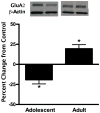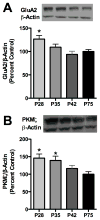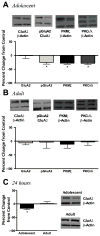Ethanol dose-dependently elicits opposing regulatory effects on hippocampal AMPA receptor GluA2 subunits through a zeta inhibitory peptide-sensitive kinase in adolescent and adult Sprague-Dawley rats
- PMID: 25218807
- PMCID: PMC4482479
- DOI: 10.1016/j.neuroscience.2014.09.003
Ethanol dose-dependently elicits opposing regulatory effects on hippocampal AMPA receptor GluA2 subunits through a zeta inhibitory peptide-sensitive kinase in adolescent and adult Sprague-Dawley rats
Abstract
AMPA receptor GluA2 subunits are strongly implicated in cognition, and prior work suggests that these subunits may be regulated by atypical protein kinase C (aPKC) isoforms. The present study assessed whether hippocampal and cortical AMPA receptor GluA2 subunit regulation may be an underlying factor in known age-related differences to cognitive-impairing doses of ethanol, and if aPKC isoforms modulate such responses. Hippocampal AMPA receptor GluA2 subunit, protein kinase Mζ (PKMζ), and PKCι/λ expression were elevated during adolescence compared to adults. 1 h following a low-dose (1.0-g/kg) ethanol exposure, hippocampal AMPA receptor GluA2 subunit serine 880 phosphorylation was decreased in adolescents, but was increased in adults. Age-dependent changes in GluA2 subunit phosphorylation were paralleled by alterations in aPKC isoforms, and zeta inhibitory peptide (ZIP) administration prevented ethanol-induced increases in both in adults. Ethanol-induced changes in GluA2 subunit phosphorylation were associated with delayed regulation in synaptosomal GluA2 subunit expression 24 h later. A higher ethanol dose (3.5-g/kg) failed to elicit changes in most measures in the hippocampus at either age. Similar to the hippocampus, analysis of cerebral cortical tissue also revealed age-related declines. However, no demonstrable effects were found following a low-dose ethanol exposure at either age. High-dose ethanol exposure reduced adolescent GluA2 subunit phosphorylation and aPKC isoform expression that were again accompanied by delayed reductions in synaptosomal GluA2 subunit expression. Together, these results suggest that GluA2-containing AMPA receptor modulation by aPKC isoforms is age-, region- and dose-dependently regulated, and may potentially be involved in developmentally regulated ethanol-induced cognitive impairment and other ethanol behaviors.
Keywords: AMPA receptors GluA2 subunits; PKCι/λ; PKMζ; adolescence; ethanol; protein kinase C (PKC).
Copyright © 2014 IBRO. All rights reserved.
Conflict of interest statement
The authors declare no conflicts of interest.
Figures






Similar articles
-
Molecular and behavioral characterization of adolescent protein kinase C following high dose ethanol exposure.Psychopharmacology (Berl). 2014 Apr;231(8):1809-20. doi: 10.1007/s00213-013-3267-6. Epub 2013 Sep 20. Psychopharmacology (Berl). 2014. PMID: 24051603 Free PMC article.
-
Hippocampal AMPA autoreceptors positively coupled to NMDA autoreceptors traffic in a constitutive manner and undergo adaptative changes following enriched environment training.Neuropharmacology. 2011 Dec;61(8):1282-90. doi: 10.1016/j.neuropharm.2011.07.032. Epub 2011 Jul 30. Neuropharmacology. 2011. PMID: 21820454
-
Dynamic increases in AMPA receptor phosphorylation in the rat hippocampus in response to amphetamine.J Neurochem. 2015 Jun;133(6):795-805. doi: 10.1111/jnc.13067. Epub 2015 Mar 2. J Neurochem. 2015. PMID: 25689263 Free PMC article.
-
Hyperammonemia alters membrane expression of GluA1 and GluA2 subunits of AMPA receptors in hippocampus by enhancing activation of the IL-1 receptor: underlying mechanisms.J Neuroinflammation. 2018 Feb 8;15(1):36. doi: 10.1186/s12974-018-1082-z. J Neuroinflammation. 2018. PMID: 29422059 Free PMC article.
-
Protein kinase Mζ-dependent maintenance of GluA2 at the synapse: a possible target for preventing or treating age-related memory decline?Rejuvenation Res. 2013 Aug;16(4):327-9. doi: 10.1089/rej.2013.1448. Rejuvenation Res. 2013. PMID: 23679685 Review.
Cited by
-
Metabotropic and ionotropic glutamate receptors as potential targets for the treatment of alcohol use disorder.Neurosci Biobehav Rev. 2017 Jun;77:14-31. doi: 10.1016/j.neubiorev.2017.02.024. Epub 2017 Feb 24. Neurosci Biobehav Rev. 2017. PMID: 28242339 Free PMC article. Review.
-
Silencing synaptic MicroRNA-411 reduces voluntary alcohol consumption in mice.Addict Biol. 2019 Jul;24(4):604-616. doi: 10.1111/adb.12625. Epub 2018 Apr 17. Addict Biol. 2019. PMID: 29665166 Free PMC article.
-
Age-dependent regulation of GABA transmission by kappa opioid receptors in the basolateral amygdala of Sprague-Dawley rats.Neuropharmacology. 2017 May 1;117:124-133. doi: 10.1016/j.neuropharm.2017.01.036. Epub 2017 Feb 3. Neuropharmacology. 2017. PMID: 28163104 Free PMC article.
-
Cytoplasmic phospholipase A₂ modulation of adolescent rat ethanol-induced protein kinase C translocation and behavior.Neurochem Res. 2015 May;40(5):1023-31. doi: 10.1007/s11064-015-1557-6. Epub 2015 Mar 20. Neurochem Res. 2015. PMID: 25791059 Free PMC article.
-
Kinases of eIF2a Switch Translation of mRNA Subset during Neuronal Plasticity.Int J Mol Sci. 2017 Oct 22;18(10):2213. doi: 10.3390/ijms18102213. Int J Mol Sci. 2017. PMID: 29065505 Free PMC article. Review.
References
-
- An L, Yang Z, Zhang T. Imbalanced synaptic plasticity induced spatial cognition impairment in male offspring rats treated with chronic prenatal ethanol exposure. Alcohol Clin Exp Res. 2013;37:763–70. - PubMed
-
- Bellinger FP, Davidson MS, Bedi KS, Wilce PA. Neonatal ethanol exposure reduces AMPA but not NMDA receptor levels in the rat neocortex. Brain Res Dev Brain Res. 2002;136:77–84. - PubMed
Publication types
MeSH terms
Substances
Grants and funding
LinkOut - more resources
Full Text Sources
Other Literature Sources

